
The 2020 Global Landscape
 | The 2020 Global Landscape by the United States National Intelligence Council At no time since the formation of the Western alliance system in 1949 have the shape and nature of international alignments been in such a state of flux. The end of the Cold War shifted the tectonic plates, but the repercussions from these momentous events are still unfolding. Emerging powers in Asia, retrenchment in Eurasia, a roiling Middle East, and transatlantic divisions are among the issues that have only come to a head in recent years. The very magnitude and speed of change resulting from a globalizing world – apart from its precise character – will be a defining feature of the world out to 2020. Other significant characteristics include: the rise of new powers, new challenges to governance, and a more pervasive sense of insecurity, including terrorism. As we map the future, the prospects for increasing global prosperity and the limited likelihood of great power conflict provide an overall favorable environment for coping with what are otherwise daunting challenges. The role of the United States will be an important variable in how the world is shaped, influencing the path that states and nonstate actors choose to follow. New Global Players The likely emergence of China and India, as well as others, as new major global players – similar to the advent of a united Germany in the 19th century and a powerful United States in the early 20th century – will transform the geopolitical landscape, with impacts potentially as dramatic as those in the previous two centuries. In the same way that commentators refer to the 1900s as the “American Century,” the 21st century may be seen as the time when Asia, led by China and India, comes into its own. A combination of sustained high economic growth, expanding military capabilities, and large populations will be at the root of the expected rapid rise in economic and political power for both countries. Most forecasts indicate that by 2020 China’s gross national product (GNP) will exceed that of individual Western economic powers except for the United States. India’s GNP will have overtaken or be on the threshold of overtaking European economies. Because of the sheer size of China’s and India’s populations – projected by the US Census Bureau to be 1.4 billion and almost 1.3 billion respectively by 2020 – their standard of living need not approach Western levels for these countries to become important economic powers. More firms will become global, and those operating in the global arena will be more diverse, both in size and origin, more Asian and less Western in orientation. Such corporations, encompassing the current, large multinationals, will be increasingly outside the control of any one state and will be key agents of change in dispersing technology widely, further integrating the world economy, and promoting economic progress in the developing world. Their ranks will include a growing number based in such countries as China, India, or Brazil. While North America, Japan, and Europe might collectively continue to dominate international political and financial institutions, globalization will take on an increasingly non-Western character. By 2020, globalization could be equated in the popular mind with a rising Asia, replacing its current association with Americanization. […] Pervasive Insecurity We foresee a more pervasive sense of insecurity – which may be as much based on psychological perceptions as physical threats – by 2020. Even as most of the world gets richer, globalization will profoundly shake up the status quo – generating enormous economic, cultural, and consequently political convulsions. With the gradual integration of China, India, and other emerging countries into the global economy, hundreds of millions of working-age adults will become available for employment in what is evolving into a more integrated world labor market. This enormous work force – a growing portion of which will be well educated – will be an attractive, competitive source of low-cost labor at the same time that technological innovation is expanding the range of globally mobile occupations. The transition will not be painless and will hit the middle classes of the developed world in particular, bringing more rapid job turnover and requiring professional retooling. Outsourcing on a large scale would strengthen the anti-globalization movement. Where these pressures lead will depend on how political leaders respond, how flexible labor markets become, and whether overall economic growth is sufficiently robust to absorb a growing number of displaced workers. […] |
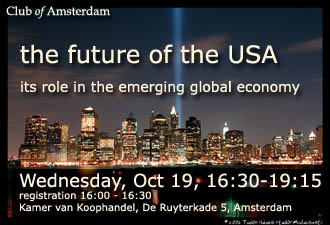
News about the future of the USA

The FBI Strategic Plan, 2004-2009
[…] The FBI forecasts that sub-national and non-governmental entities will play an increasing role in world affairs for years to come, presenting new “asymmetric” threats to the United States. Although the United States will continue to occupy a position of economic and political leadership — and although other governments will also continue to be important actors on the world stage — terrorist groups, criminal enterprises, and other non-state actors will assume an increasing role in international affairs. Nation states and their governments will exercise decreasing control over the flow of information, resources, technology, services, and people.
Globalization and the trend of an increasingly networked world economy will become more pronounced within the next five years. The global economy will stabilize some regions, but widening economic divides are likely to make areas, groups, and nations that are left behind breeding grounds for unrest, violence, and terrorism. As corporate, financial, and nationality definitions and structures become more complex and global, the distinction between foreign and domestic entities will increasingly blur. This will lead to further globalization and networking of criminal elements, directly threatening the security of the United States.
Most experts believe that technological innovation will have the most profound impact on the collective ability of the federal, state, and local governments to protect the United States. Advances in information technology, as well as other scientific and technical areas, have created the most significant global transformation since the Industrial Revolution. These advances allow terrorists, disaffected states, weapons proliferators, criminal enterprises, drug traffickers, and other threat enterprises easier and cheaper access to weapons technology. Technological advances will also provide terrorists and others with the potential to stay ahead of law enforcement countermeasures. For example, it will be easier and cheaper for small groups or individuals to acquire designer chemical or biological warfare agents, and correspondingly more difficult for forensic experts to trace an agent to a specific country, company, or group. […]

United States Is Key Provider of Food Aid for World’s Poor
The United States is the major player in feeding the world’s poor through bilateral, private, and especially multilateral food distribution programs around the globe, according to Tony P. Hall, U.S. ambassador to the United Nations Food and Agriculture Organization.
As the chief of the U.S. Mission to the U.N. Agencies in Rome – the World Food Program (WFP), the Food and Agriculture Organization (FAO) and the International Fund for Agricultural Development (IFAD) – Ambassador Hall is responsible for “putting into action America’s commitment to alleviate hunger and build hope in the world.”
News about the future

IBM Won’t Use Genetic Info for Hiring, Benefits
By Reuters
IBM said it would refrain from using the data in determining eligibility for health-care or benefits plans.
The Genetic Alliance, a Washington-based patients advocacy group, called IBM’s policy “remarkable” and predicted it would spur other U.S. corporations to follow suit.

Worldwide Professional Development
Intel Teach to the Future is a worldwide effort to help both experienced teachers and Pre-Service teachers integrate technology into instruction to develop students’ higher-order thinking skills and enhance learning. Participating teachers receive extensive instruction and resources to promote effective technology use in the classroom.
Teachers learn from other teachers how, when, and where to incorporate technology tools and resources into their lesson plans. In addition, they experience new approaches to create assessment tools and align lessons with educational learning goals and standards. The program incorporates use of the Internet, Web page design, and student projects as vehicles to powerful learning.
Next Event: Wednesday, October 19, 16:30-19:15

the future of the USA – its role in the emerging global economy
Wednesday, October 19, 2005
Registration: 16:00-16:30, Conference: 16:30-19:15
Where: Kamer van Koophandel Amsterdam – Netherlands Chamber of Commerce, De Ruyterkade 5, 1013 AA Amsterdam
With
Richard Huss, Economic Counselor, U.S. Embassy: The future role of the United States in the global economy
Hans R. Langeveld, Managing Partner, Maes & Lunau Executive Search
Peter R. Luiks, CEO, Asian Centre for Consulting Excellence: From world dominance to world leadership
and our Moderator Homme Heida, Promedia, Member of the Club of Amsterdam Round Table
National Basic Research Program of China
National Basic Research Program of China
973 Program
The National Basic Research Program (also called 973 Program) is China’s on-going national keystone basic research program, which was approved by the Chinese government in June 1997 and is organized and implemented by the Ministry of Science and Technology.
The strategic objectives of the 973 Program are to strengthen the original innovations and to address the important scientific issues concerning the national economic and social development at a deeper level and in a wider scope, so as to improve China’s capabilities of independent innovations and to provide scientific support for the future development of the country.
This program has four main tasks. The first is to conduct multidisciplinary comprehensive research and provide theoretic and scientific foundations for the settlement of the important scientific issues regarding the development of the national economy and society as well as the science itself in the fields of agriculture, energy, information, resource and environment, population and health, materials, and etc. The second is to deploy relevant, important and explorative forefront basic researches. The third is to nurture a number of outstanding personnel with high scientific qualification and creative capability, whom could be to meet the requirements of development in the 21st century. The fourth is to built a group of high-level scientific and technological assignments of the country, thus constituting some interdisciplinary scientific research centers.
Through the in-depth implementation of the 973 Program, we should be further upgrade the scientific and technological level, particularly the overall level of basic research, so as to make due contributions to the grand objectives of making China a scientific and technological power by mid-21st century.
Agriculture
| Ecosystem Reconstruction Mechanism and Optimized Eco-productive Paradigm of Glassland and Farming-Pastoral Zone of Northern China The vast grassland in Northern China, and especially the transitional zone between pastoral and farming regions adjacent southeastward to the grassland, with a population of 62 million and occupying an acreage of 12% of the country‘s territory, are the key areas for national economy and the sensitive front for national eco-environmental conservation. They are also the key strategic areas for national food supply in the new century and for national ecological security. This project, in order to reveal the scientific laws of increasing ecosystem‘s productivity and keeping ecological security and restoring injured ecosystems of the areas at the same time, will do a series of researches in the following seven aspects: | |
| 1) Biological fundaments of gene pool of forage grass and livestock 2) Mechanisms of wind erosion and water erosion and of grassland deterioration in he transitional zone between pastoral and farming regions 3) Mechanisms of formation of ecosystem‘s productivity in the transitional zone between pastoral and farming regions 4) Rational patterns of ecological security and land-use in the transitional zone between pastoral and farming region 5) Models of restoration of degenerated ecosystems and their virtual simulations 6) Mechanisms of integration of farming pastoral-forestry ecosystems and their productivity‘s coupling 7) Theoretical foundations of the optimized eco-productive paradigms and the formation of new production belt. | |
| The project will strive to reveal the mechanisms of degeneration of grassland ecosystems, the mechanisms of energy and materials transformations and formations of productivity within SVAT in farming-pastoral ecosystems, functions of coupling- magnifying productivity within farming-pastoral–forestry ecosystems, reform the land use patterns under the premise of ecological security and establish optimized eco-productive paradigms with high efficiency of water and land resources uses. The project will also try hard to develop a new regional division of production and promote the formation of new production belt, to lay a sound foundation for decision-making by related national departments. Meanwhile, this project is expecting to make great contributions to many basic scientific fields of restoration ecology, ecosystem‘s productivity ecology, theoretic ecology and alike. Energy Fundamentals of Large-scale Production, Storage and Transportation of Hydrogen and the related Fuel Cells From the viewpoint of energy resource, environmental effects and sustainable development of national economy, this project will concentrate on fundamental scientific problems of large-scale production, storage and transportation of hydrogen and on the related fuel cells, and as a result, a theoretical system about hydrogen and its fuel cell will be established. This project will study and manage to solve the following key scientific problems: 1) Adsorption and desorption behavior and mechanism of hydrogen under super-critical condition; 2) Molecular design fundamentals of catalysts, relationship between their microstructure and performance, and the mechanism of electric catalysis process; 3) Fabrication science of key materials; 4) Reaction science of multi-phase fluid and the failure mechanism of fuel cell stacks. Hydrogen uptake mechanism and super-critical adsorption theory of nano-structured carbon materials, reaction mechanism of high-speed reforming of hydrogen on-board vehicles and the failure theory of fuel cell stacks will be proposed. New catalysts, new hydrogen storage materials and new proton exchange film and their fabrication science will be developed. In general, a systematic knowledge frame of large-scale production, storage and transportation of hydrogen and the related fuel cells, particularly suitable for China, will be established, which can be implemented to guide the practical applications of hydrogen energy and the development of hydrogen economy in China. Population and Health Basic research of reproductive health I. Basic research for reproductive regulation. 1. Study on gene expression and regulation of spermatogenesis – New gene screen, cloning , structure and founctional regulation during spermatogenesis. 2. Basic research on the mechanism of fertilization, 1) Key molecular regulation of acrosomal reaction. 2) Regulated mechanism of sperm factor to oocyte activiation. 3) Signal transduction in the recognization between sperm and oocyte and regulation in early embryonic development. 3. Study on molecular mechanism of implantation, 1) Cloning and founctional studies of genes critical to implantation. 2) Molecular mechanism of controlling the switch on and off of implantation “window” and regulation cascade of implantation process. 3) Molecular basis of controlling invasion of trophoblasts. II. Research of etiologic mechanism of major birth defects. 1. Research of etiologic mechanism of congenital cardiac defects and cloning of congenital cardiac defects related gene. 2. Establishing a biologic information bank of birth defects with Chinese characteristics. Materiel Nanoelectronic Computation Devices – Materials, Structures and Characterization The main aim of this project is to develop next-generation nanoelectronic computing devices. It focuses on the physics of innovative concepts and architectures for nanocomputation based on quantum phenomena, new approaches to the bottom-up nanostructuring and the synthesis of novel nanoelectronic materials and nanojunctions, the nanometer scale characterization and the related techniques. The work includes: 1) Synthesis of novel nanoelectronic materials and electronically nonlinear nanojuctions. Possible approaches involve chemical synthesis of molecular functional materials and carbon nanotube-based nanojuctions, template synthesis of 0D and 1D metal and semiconductor materials, controlled growth of nanotubes and nanowires by chemical vapor deposition, chemical doping and hybridization, etc; 2) Assembly and fabrication of nanostructures. Developing new technologies and new systems for nanostructuring. The emphasis is laid on the bottom-up assembly: starting from nano-sized building blocks such as functionalized nanoparticles, chemically derived carbon nanotubes, fullerenes and organic molecules, using various weak interactions and chemical recognition to create specific nanostructures. Work also includes nanofabrication based on proximal probe techniques and focused ion beam technique; 3) Nanocharacterization. Developing new techniques for characterizing the electrical, mechanical, and chemical properties of nanomaterials and nanostructures. Scanning probe microscopy, scanning and transmission electron microscopies, and their novel combinations are mainly utilized for this purpose; 4) New concepts and architectures for logic computation. Exploring new ideas, new structures for basic logic computation from both theoretical modelling and experimental investigations. Single electronic devices and carbon nanotube devices are two main focuses. |
Recommended Book
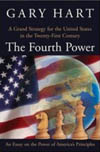
The Fourth Power: A Grand Strategy for the United States in the Twenty-First Century
by Gary Hart
Today, even as America asserts itself globally, it lacks a grand strategy to replace “containment of communism.” In this short, sharp book, Gary Hart outlines a new grand strategy, one directing America’s powers to the achievement of its large purposes. Central to this strategy is the power of American ideals, what Hart calls “the fourth power.” Constitutional liberties, representative government, press freedom – these and other democratic principles, attractive to peoples worldwide, constitute a resource that may prove as important to national security and the national interest in this dangerous new century as traditional military, economic and political might. Writes Hart: “The idea that government exists to protect, not oppress, the individual has an enormous power not fully understood by most Americans who take this principle for granted from birth. Far more nations will follow us because of the power of this ideal than the might of all our weapons.” Against those who view America’s noblest values as an inconvenience or even hindrance to the exertion of influence abroad, Hart warns that we ignore principle only at our peril. Such an approach may serve short-term goals, but there are costs; among them is the compromising of a crucial strategic asset, America’s fourth power. Certain objectives require a military response–few serious people would disagree. The question is “whether America’s purposes are best achieved through empire and force or through principle and persuasion.” To suggest the former, Hart argues, is to misread both history and our current revolutionary age, one where terrorism, the internationalization of markets, information technology, eroding nation-state authority and other realities demand not doctrines of superstate unilateralism and preemption but rather appreciation for new collective security structures, international regulatory bodies, even forms of collaborative sovereignty. Applying the best insights of strategy to statecraft, Hart finds fuzziness, overreaching, and “theological” simplicity in America’s current foreign policy. Nor does he believe the war on terror, necessary in the near term, will itself serve to chart America’s larger strategic course. A bracing vision of an America responsive to a full spectrum of global challenges, The Fourth Power calls for a deeper understanding both of the threats we face and the profound strengths at our disposal to fight them.
| GlobalSourcingNOW |
GlobalSourcingNOW is a FREE daily and weekly newsletter providing the latest updates on the global offshoring and outsourcing industry. GlobalSourcingNOW is hosted by Evalueserve, a leading provider of expert knowledge services. Industries such as Information Technology, Human Resource Management, Finance & Insurance, Knowledge Management, Customer Relationship Management, Biotechnology, Engineering, and Research & Development are extensively researched and covered by GlobalSourcingNOW. GlobalSourcingNOW newsletters reach over 22,000 subscribers across 40 countries. For further details on this, please refer to this link: http://www.globalsourcingnow.com |
The Biometric Consortium
| The Biometric Consortium The Biometric Consortium serves as a focal point for research, development, testing, evaluation, and application of biometric-based personal identification/verification technology. Biometrics are automated methods of recognizing a person based on a physiological or behavioral characteristic. Among the features measured are; face, fingerprints, hand geometry, handwriting, iris, retinal, vein, and voice. Biometric technologies are becoming the foundation of an extensive array of highly secure identification and personal verification solutions. As the level of security breaches and transaction fraud increases, the need for highly secure identification and personal verification technologies is becoming apparent. Biometric-based solutions are able to provide for confidential financial transactions and personal data privacy. The need for biometrics can be found in federal, state and local governments, in the military, and in commercial applications. Enterprise-wide network security infrastructures, government IDs, secure electronic banking, investing and other financial transactions, retail sales, law enforcement, and health and social services are already benefiting from these technologies. A few examples: |
| Voice/Speaker |
IBM Conversational Biometrics Group
IBM is utilizing two key technologies – speaker verification and conversational systems – to provide enhanced security for voice-based transactions.
Conversational Biometrics(CB) technology enables a non-intrusive and highly accurate mechanism for determining and authenticating user identities, based on the analysis of their voice. Unlike other biometrics, voice contains multiple sources of information that can be acquired using existing ubiquitous infrastructure and used for recognizing and verifying user identities. The primary source is the user’s voiceprint, which can be analyzed purely from an acoustic perspective, without considering the content being spoken.
| Retinal |
| Retinal Biometric Technology The human retinal vasculature is safely protected from intentional or accidental tampering. Stable from birth to death, the retinal vasculature disappears within seconds of the cessation of life, thereby insuring that the captured image was obtained from a living user. Retica offers the most accurate biometric identification technology available today. The Retica system successfully exploits the full potential of the unique vessel pattern found at the posterior of the eye into a four-phase solution that captures, collects, stores and identifies retinal biometric information Face SureMatch 3D Real-life applications demand reliable performance. Much of today’s facial recognition technology simply cannot provide adequate performance because of the fundamental limitations of 2D. Other biometrics such as fingerprint and iris cannot identify suspects at a distance, non-cooperatively. The answer lies in 3D technology. Pose, lighting, and expression have historically prevented 2D facial recognition from working well. Genex has addressed these problems by drawing upon its extensive research in 3D imaging and 2D-to-3D facial structure conversion. |
VISION 2050: An Integrated National Transportation System
VISION 2050: An Integrated National Transportation System
by the US Federal Transportation Advisory Group
The Nation needs a new transportation vision for the next 50 years. Its economic strength and the quality of life of all Americans depend on it. We call upon the President to lead this effort.
1. Presidential Leadership. Declare that improving the Nation’s transportation system is a top priority. Form a bipartisan commission to determine the steps necessary to achieve the vision laid out in this document.
2. National Strategy. Develop a National Transportation Strategy by January 2002 to guide transportation policy and investments.
3. Multi-modal Leadership.Create a permanent Federal Advisory Committee, that reports directly to the Secretary of Transportation, with representatives from all stakeholders to provide guidance on national transportation policy issues from a long-term, systemic perspective.
4. National System Architecture. Form a non-profit, public-private sector organization, like ITS America, to help the government define and maintain a national transportation system architecture.
5. People. Determine transportation work force needs over the next 50 years and develop a plan for ensuring that the required work force is available.
6. Research. Significantly increase funding for long-term, high risk enabling research over the next 10 years. Create a civilian Advanced Research Projects Agency to stimulate and demonstrate high-risk, high-payoff transportation technologies and concepts with the transportation sector to accelerate their deployment.
7. Infrastructure. Work with the transportation sector to implement the partnership for the advancement of infrastructure renewal and operational improvements. Integrate civilian and commercialtransportation into our defense system’s global information grid. Ensure adequate resources and expertise to maintain and operate the Nation’s information infrastructure for transportation. Determine the infrastructure required for an economy based on non-carbon fuels and identify transition issues.
8. Partnership. Foster partnership arrangements throughout the transportation community to provide incentives to work together to eliminate the social, institutional and cultural barriers that hinder success, especially in the areas of multi-modal and information technology partnerships.
9. Legal and Regulatory Framework. Create a government- university-industry task force to identify ways to eliminate the regulatory and legal barriers to innovation in transportation.
10. Capital. Create a transportation investment fund with the transportation sector that would provide the research and development necessary to spur innovative and system-level solutions in transportation.
Club of Amsterdam Agenda
| NEW: .Our Season Events are Wednesdays 16:30! | |
| 16:00-16:30 Registration 16:30-17:45 Part I: Presentations 17:45-18:15 Break: Drinks and evtl. live music 18:15-19:15 Part II: Discussion | |
| Club of Amsterdam Season Events 2005/2006 | |
| .Oct 19 | the future of the USA Where: Kamer van Koophandel Amsterdam – Netherlands Chamber of Commerce, De Ruyterkade 5, 1013 AA Amsterdam |
| .Nov 30 | the future of Software Architecture Where: Syntens, De Ruyterkade 5, 1013 AA Amsterdam [Building of the Chamber of Commerce] |
| .Jan 25 | the future of Futurist Tools |
| .Mar 1 | the future of Electronic Identity |
| .Mar 29 | the future of Governance |
| .Apr 26 | the future of Drugs & Pharma |
| .May 31 | the future of Reputation Management |
| .Jun 28 | the future of Journalism / Ethics in Journalism |
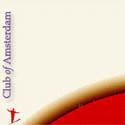
Club of Amsterdam Open Business Club
| Club of Amsterdam Open Business Club Are you interested in networking, sharing visions, ideas about your future, the future of your industry, society, discussing issues, which are relevant for yourself as well as for the ‘global’ community? The future starts now – join our online platform – and it’s for free … |
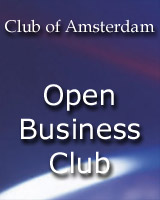

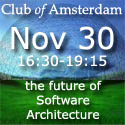
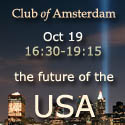


Customer Reviews
Thanks for submitting your comment!